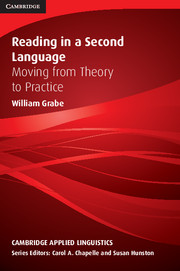Book contents
- Frontmatter
- Contents
- Series editors' preface
- Preface
- I FOUNDATIONS OF READING
- Chapter 1 The nature of reading: Defining reading
- Chapter 2 How reading works: The building blocks of fluency and comprehension
- Chapter 3 How reading works: Comprehension processes
- Chapter 4 Cognitive issues in reading
- Chapter 5 Models and more models of reading: Explaining reading
- II PATTERNS OF VARIATION IN READING
- III DEVELOPING READING COMPREHENSION ABILITIES
- IV EXPANDING READING COMPREHENSION SKILLS
- References
- Author Index
- Subject Index
Chapter 3 - How reading works: Comprehension processes
from I - FOUNDATIONS OF READING
Published online by Cambridge University Press: 05 August 2012
- Frontmatter
- Contents
- Series editors' preface
- Preface
- I FOUNDATIONS OF READING
- Chapter 1 The nature of reading: Defining reading
- Chapter 2 How reading works: The building blocks of fluency and comprehension
- Chapter 3 How reading works: Comprehension processes
- Chapter 4 Cognitive issues in reading
- Chapter 5 Models and more models of reading: Explaining reading
- II PATTERNS OF VARIATION IN READING
- III DEVELOPING READING COMPREHENSION ABILITIES
- IV EXPANDING READING COMPREHENSION SKILLS
- References
- Author Index
- Subject Index
Summary
Comprehension is not a unitary phenomenon but rather a family of skills and activities. A general component in many definitions of comprehension is the interpretation of the information in the text…. At the core of comprehension is our ability to mentally interconnect different events in the text and form a coherent representation of what the text is about.
(Kendeou et al., 2007: 28–9)Unlike the converging perspectives on the role of lower-level processing to support reading comprehension, the various activities and processes that define higher-level processes are not as uniformly specified in the comprehension literature. However, research over the past 10 years has built a coherent synthesis of how higher-level processes contribute to comprehension. Because there is far more research being carried out on higher-level processes now than 15 years ago (cf. Gernsbacher, 1997; Kintsch, 1998; Long, Johns, & Morris, 2006; Noordman & Vonk, 1999; Perfetti, 1999; Rapp et al., 2007; Zwaan & Rapp, 2006), accumulating evidence gives us some confidence in the overview that follows.
Higher-level processes generally assume that the reader can direct attentional resources to these component skills. Such a requirement is a key feature of higher-level processing. At the same time, many aspects of these higher-level component abilities can, and often are, carried out in automatic mode except when difficulties arise or when specific goals highlight attentional resource needs. For example, reading to learn information for a test will likely lead a reader to attend consciously to linkages among main ideas in a text.
- Type
- Chapter
- Information
- Reading in a Second LanguageMoving from Theory to Practice, pp. 39 - 58Publisher: Cambridge University PressPrint publication year: 2008



